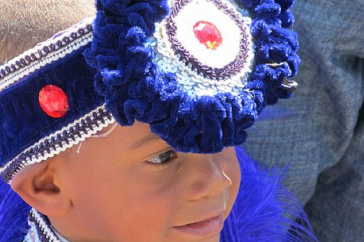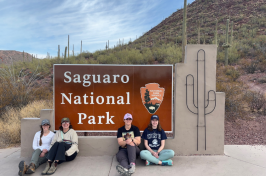Hurricane Katrina Transformed Mardi Gras Indians, UNH Student Finds

A young Mardi Gras Indian boy "masks" on Super Sunday, March 20, 2011. View more photos in our slideshow.
DURHAM, N.H. - Six years after Hurricane Katrina, the Mardi Gras Indians have rebounded and been transformed into a reenergized community where the youth are increasingly interested in carrying on the culturally rich traditions of these New Orleans tribes.
This is the key finding of University of New Hampshire anthropology student Kendra Hanlon of Auburn, who spent the summer of 2011 in New Orleans researching the Mardi Gras Indians on a summer undergraduate research fellowship provided by UNH's Hamel Center for Undergraduate Research.
"The most important thing I've learned is that the tribes fully understand how unique and special it is what they do. They have become stronger and stronger, and the youth and the youth communities have realized how special these traditions are, especially in the face of losing everything," Hanlon says.
"Without a doubt, the youth have always realized the importance of these traditions, but not necessarily the importance of being involved with them," she says. "They took a step back and realized that this was their culture and history, and that it was important."
Hanlon became interested in researching the Mardi Gras Indians after taking UNH Prof. Bill Ross's class "New Orleans: Place, Meaning and Context" and volunteering with Operation Helping Hands of Catholic Charities, Archdiocese of New Orleans, to rebuild homes after Hurricane Katrina. She would like to continue her research on the Mardi Gras Indians as part of her honor's senior thesis.
"Bill's class is just a phenomenal class. It changed the course of my college education, which you never expect from a general education class," Hanlon says. "Everything snowballed from that class. When I started thinking about what I wanted to do for a research project, doing research on the Mardi Gras Indians won me over. There is nothing else like them in the world. I never feel done with them."
Ross had read about the Mardi Gras Indians but became quite interested in them when he saw his first Indian parade in March 2007. "It was an awesome introduction to the tradition, but it was hard to describe to those who hadn't experienced it. However, in 2010, Kendra's class had the opportunity to see the Mardi Gras Indians mask on the evening of St. Joseph's Day on March 19, and I suspect that helped spawn her interest in this project," he said.
Researching the Mardi Gras Indians -- especially doing field research and speaking with members of tribes -- has been a challenge for Hanlon since the community, which was hard hit by Hurricane Katrina, is quite private and protective. "They've always had people who have a particular angle try to thrust themselves into their community. I don't have an angle other than I want to learn," she says.
To outsiders, the Mardi Gras Indians may be best known for their intricate and detailed beaded costumes, which they work on for most of the year prior to "masking" on Mardi Gras Day, the evening St. Joseph's Day, and Super Sunday, which is the Sunday closest to St. Joseph's Day. Hanlon explains that the costumes have a Native American feel to reflect the respect held by the Mardi Gras Indians for the Native Americans who helped African Americans in the region escape from slavery in the 1800s.
"They were some of the first free African Americans in this country. To honor the Native Americans, they mask in this way," she says.
However, the Mardi Gras Indians have strong ties to their African American roots, as well, although each tribe is unique in its customs and traditions.
Hanlon chose to study the Mardi Gras Indian culture because she is considering a career as a preservationist. "Whether I am working to preserve a group that tries to continue its cultural practices or preserve artifacts from thousands of years ago, preservation of culture and history is what allows us to educate ourselves about where we come from, how we have evolved to where we are today, and from there, how we can better learn from our history for the future," she says.
And none of her research would have been possible without her summer undergraduate research fellowship provided by UNH's Hamel Center for Undergraduate Research, which provides the resources and financial support for the research, scholarly, and creative projects of UNH students.
"I owe them all of this. I applaud UNH for having so many research grant opportunities. Not many schools have so many research opportunities for undergraduates, and I am so thankful I went to UNH," Hanlon said.
The University of New Hampshire, founded in 1866, is a world-class public research university with the feel of a New England liberal arts college. A land, sea, and space-grant university, UNH is the state's flagship public institution, enrolling 12,200 undergraduate and 2,300 graduate students.
SLIDESHOW
http://unh.edu/ucm/slideshows/mardigras/
-30-
EDITORS AND REPORTERS: UNH student Kendra Hanlon can be reached at mailto:kendra.hanlon88@gmail.com"
Latest News
-
November 6, 2025
-
November 5, 2025
-
October 24, 2025
-
October 8, 2025
-
October 2, 2025
















































